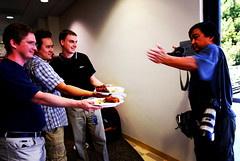I just posted some thoughts on my new role at Plaxo as their Chief Platform Architect. Like my previous roles at Plaxo, this is both a formalization of something I was already doing and a decision to focus more intensely on it. In this case, it’s because Plaxo has ended up in a potentially pivotal position to help keep track of who you know and what they’re doing across all the various sites and services you and your contacts use.
So many services these days are driven by sharing content with your friends/contacts/etc. and yet the problem of wiring up who you know on each of these services and keeping that up-to-date is as unsolved as ever. At best you get a one-time auto-import from webmail providers, but if we’ve learned anything at Plaxo, it’s that persistent sync with your existing address book(s) is the real ticket, and everything else falls short of what users really want–that any time I meet someone new or they join a new service, I can automatically find out about it and stay in touch with them without leaving my existing tools. It’s a hard problem, and one that’s not core to most companies, but it’s Plaxo’s bread-and-butter so we’re eager to dive in.
Actually, It’s kind of funny in retrospect that Plaxo launched in 2002–before Friendster, before flickr, before LinkedIn, before MySpace, before Facebook, etc. Even way back then (heh), we thought the problem of staying connected to the people you know was hard enough to warrant starting a company. The initial pitch pointed out that the “explosion of communication tools” (meaning, at the time, email, IM, and cell phones) was actually making it harder to stay in touch, because there were so many channels to keep track of now, and they all tended to be incomplete and out-of-date. Boy is that ever more true today than it was five years ago! Just like before, all these new tools ostensibly aim to help you stay more connected, but they can only truly deliver in conjunction with a service like Plaxo to help you manage it all.
The good news is that these days we’re in the best position yet to make a difference in this new social web. We have 15+ Million people already using Plaxo, we have 2-way sync with most of the major address books and calendars out there, and most importantly we have built our service on open standards like SyncML, vCard, iCal, etc. that will enable others to pick up where we’ve left off.
This last point is really the starting place for my new role as Chief Platform Architect. We are fortunate to be part of a community of developers and evangelists that cares deeply about keeping the social web open–and thus interoperable. I’ve spent the last few years participating in events like the FOAF Workshop, MashupCamp, Internet Identity Workshop, OSCON, and others, trying to figure out how the community envisions building a user-centric social web and how I and Plaxo can best help. It’s exciting to see the fruits of these events start to ripen–things like OpenID, microformats, cross-site mashups, standards-based identity agents–and even more exciting to get to spend my days figuring out how Plaxo can continue to embrace them, help them continue to develop and flourish, and use our technology and resources to help get them deployed at web-scale.
The company is firmly behind this effort and everyone here gets why open is the way to go. In fact, it’s really the only way to go for us–if you believe (as we do) that people will continue to use multiple tools and services and that no single site will own everything (i.e. if you believe that “the web will continue to be the web”) then you can’t wire everything up in a top-down fashion. You have to agree on standards, keep users in control, and empower them to let their data follow them around wherever they go and share it with whomever they want. There’s still a hard problem to solve in the implementation and operation of such a system, and that’s where Plaxo (and others) will be able to run a thriving business. But believe me, we’ve already written one-too-many custom authentication and sync conduits and we long for the day when a new service can just point their standard sync endpoint at us and the rest is done automagically. The day where I can join a new service and instantly find out everyone I know there–including people that I meet or that join later on. That’s the goal, that’s what I’m working on. Let me know what you think!








